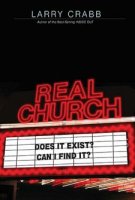Crabb, Larry. Real Church. Nashville: Thomas Nelson, 2002.
As the subtitle reads, this book explores if the real church actually exists, and what constitutes a real church. Crabb, in his uncanny wit and direct frankness, explores the state and situation of the church, mainly in the context of North America. He then moves to 3 common misconceptions of what a church exists for, namely for a better life, to save ourselves and others, and to change the world. He then unpacks his own definition of a real church, focusing on 4 areas, namely spiritual theology, formation, community and mission.
The church I want to be part of, a real church, will teach spiritual theology that stirs a hunger for spiritual formation that surfaces the need for spiritual community that then marshals its resources for spiritual mission.
Not being familiar with Crabb’s earlier and popular books e.g. Inside Out, I initially found his style and comments rather suspicious and a little too tongue-in-cheek, though I understand he was being extreme and in-your-face for emphasis, and also speaking his mind, but slowly then drawing the audience to think outside the box, for themselves, and also get drawn into his reasoning and unpacking which comes subsequently. The content and material he puts forth is not new, but still refreshing, especially his take of what many Christians view as church, or what church should be for. I find him leaning towards emergent church theology, though he mentions clearly at least twice his misgivings and concerns about the movement. He also uses terms and phrases that don’t necessary sit well with evangelical theology, e.g. dancing with the Trinity, addiction to God, hearing heaven’s music, etc. Also, I find that the book is a little imbalanced, because he spends so much time reflecting on the state of the church, and misconceptions of the purposes of a church, it seems he rushes through the 4 areas, and before it can reach a climax, ends rather abruptly, concluding that theology is the thing that draws the other 3 together, without really explaining too much why and how. Instead, he leaves us thirsty for more, which creates a great plug-in for his other book 66 Love Letters, which he then promotes. On purpose, or just in line with his conclusion? I leave it to you to decide.
Disclosure of Material Connection: I received this book free from Thomas Nelson Publishers as part of their BookSneeze.com <http://BookSneeze.com> book review bloggers program. I was not required to write a positive review. The opinions I have expressed are my own. I am disclosing this in accordance with the Federal Trade Commission’s 16 CFR, Part 255 <http://www.access.gpo.gov/nara/cfr/waisidx_03/16cfr255_03.html>: “Guides Concerning the Use of Endorsements and Testimonials in Advertising.”





